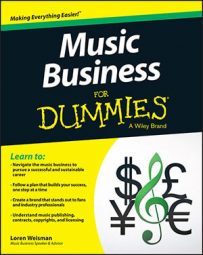Think of your website as your home base, where everything out there in the music business links back to you. On the opposite side, this is where you can link everything to send people out to all your different social media sites like Facebook and Twitter, stores like iTunes and Amazon, audio sites, streaming sites, video sites, picture sites, blog sites, and everywhere else.
Directing people where to go
Your website should present the basic details and directions for where your fans can go to find out more about you as well as have the right information for industry professionals, reviewers, and booking agents.
The website also enables people to come back from one social media site and be able to find all the other social media sites you are on. This way they can choose where they prefer to connect with you.
Whereas you might think Facebook is where you want everyone to be, a fan that primarily uses Tumblr could click through on a Facebook post they came across to your website and find your Tumblr link clearly accessible and visible on the home page of your website, which they could then choose to click on and stay connected with you there by subscribing to updates or following you.
Don’t force fans to follow you on one specific site. Give them the opportunity and the option to connect where they want.
Populating your website
To get started, a good rule of thumb is to make sure the fundamentals are in place. This enables the easiest website to build and delivers the best results. The following lists the basics that are required for an easy-to-use website.
| Home | Equipment/endorsement links |
| Bio | Promotional/booking info/downloads |
| Pictures | Copyright notice |
| Videos | Privacy policy |
| Music | Contact information |
| Blog | Email list signup |
| Schedule | Subscribe/unsubscribe |
| Products | Store links |
| Reviews and testimonials | Social media |
Your website is where the main information is placed on one scrolling page with links to other subsidiary pages while still sharing the core information. This format also looks clean on mobile phones and tablet devices.
Many of these requirements are able to come from your social media pages and updated automatically in to your website. For example, the YouTube plug-in called TubePress automatically updates your video page on your website with the videos you post on YouTube.
The same plug-ins pull pictures from Instagram, audio samples from SoundCloud, and blogs from your blogging page. This gives you the ability to consistently update your website without needing to even visit your site. Still, it’s important to create new content on a weekly basis that’s put directly on your website to help with your SEO.
The top of your website or the first page that shows up on computers or mobile devices should immediately give everyone a strong sense of who you are. Your logo, font, color scheme, and tagline should be present.
Have links visible and immediately available to direct visitors to Facebook, Twitter, YouTube, and Instagram for social media. Also provide clear tabs for people to get to your music, bio, and your contact info.
Don’t make people sign up to see your website or force them to like a page to enable them to get more information. It turns people away. You can have exclusive content that people have to sign up for, but don’t make your first appearance be met with forcing a website visitor to sign up for an email list or like a page before they get a chance to decide if they like you.
Letting professionals do it right
Although you can easily build a free website, you should consider using a professional web designer to design your site the right way. A well-designed site coupled with a content management system ends up saving you thousands along with giving you the ability to change the site yourself without having to pay someone every time your content needs to be updated.
Subscribing to email lists more from your website
Email lists and enabling someone to subscribe to your website allows people to get the updates they want. Keep in mind that many of these people already are connected with you on social media sites, so as you might recap and share some previous social media posts as part of your email to fans, make sure to deliver something exclusive to this list that can be seen only if they’re part of the list.
Easy access to subscribe and unsubscribe
Make it easy for someone to sign up for update, but at the same time make it easy for people to unsubscribe. Some fans don’t want the extra emails, or they may find they get updates and information from social media or other places.
Updates: How many updates and how often
Some artists send out emails every single day and oversaturate their audience. Once a week is the most you should send out updates with once a month being the best choice. This monthly time frame enables you to create exclusive content for the email list and give people a great update as well as a recap of the previous month.
Ezines, newsletters, and online newspapers
Sites such as paper.li help you create a simple newspaper and newsletter-type format where you can create headlines from URL links. You can also share other people’s content that you might like to add to the newspaper. Because the link goes directly to someone’s content based on their sites, there’s no copyright infringement; however, don’t share links to subscription or private unsecured pages without asking. It’s best to share content from public social media sites like Twitter, YouTube, Instagram, and blogs.
A newsletter or online newspaper might seem like a good link to share through your social media pages; however, it takes away the exclusivity and the connection with your audience.

